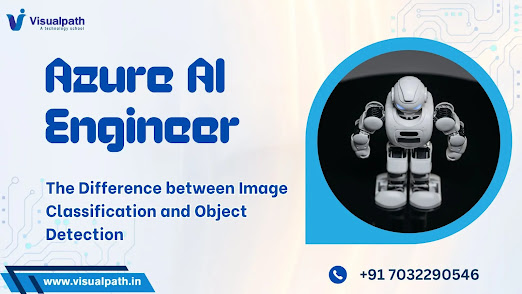- Get link
- X
- Other Apps
The Difference between Image Classification and Object Detection
Artificial
Intelligence and computer vision have introduced groundbreaking ways to interpret
images through deep learning. Two primary techniques stand out in this domain:
image classification and object detection. While they may appear similar, they
serve distinct purposes and are used in different scenarios.
 |
| The Difference between Image Classification and Object Detection |
1.
What Is Image Classification?
Image classification refers to the process of assigning a label to an
entire image. The AI model examines the visual content and determines the most
appropriate category. For example, if a photo contains a cat, the classifier
will label it as "cat."
This method is efficient for tasks where only one primary object or
theme needs to be identified. It’s typically used in scenarios like medical
image analysis, quality control in manufacturing, and basic visual
categorization. Many learners are introduced to this foundational concept
through Microsoft
Azure AI Online Training,
where they get hands-on exposure to pre-trained classification models.
2.
What Is Object Detection?
Unlike classification, object detection goes a step further. It not only
identifies what objects are present in an image but also pinpoints their exact
locations using bounding boxes. This technique is essential for applications
such as autonomous driving, video surveillance, and real-time object tracking.
For example, in an image showing a busy street, object detection can
identify multiple elements—cars, pedestrians, traffic signs—and draw bounding
boxes around each, labeling them appropriately.
3.
Key Technical Differences
·
Output: Image
classification provides a single label; object detection returns multiple
labels with coordinates.
·
Complexity: Object detection
models are more complex, requiring advanced frameworks like YOLO (You Only Look
Once), SSD (Single Shot Detector), and Faster R-CNN.
·
Data Requirement: Object detection
needs annotated images with bounding box information, whereas classification
only requires image-label pairs.
These deeper technical skills are often taught in structured programs
like Microsoft
Azure AI Engineer Training, which guide learners through building,
training, and deploying such models using Azure services.
4.
Use Cases in Real-World Applications
·
Retail: Image
classification helps categorize products; object detection assists in inventory
tracking by detecting multiple items on shelves.
·
Healthcare: Classification is
used to detect disease types in X-rays; object detection locates the affected
area.
·
Security: Image
classification might identify whether a person is wearing a mask; object
detection determines where the mask is on the face.
5.
Tools and Frameworks Used
Both techniques can be implemented using a variety of tools and
frameworks:
·
TensorFlow and PyTorch
for model training
·
Azure Cognitive Services and Azure Machine
Learning for deployment
·
OpenCV for image
processing
·
Keras for high-level
model building
Microsoft Azure, in particular, simplifies these processes through
drag-and-drop modules and integrated APIs.
6.
How to Choose Between the Two
Choosing between image classification and object detection depends on
the goal of your project:
·
Choose image
classification if the task is to identify what is in an image without
concern for location.
·
Choose object detection if you need to identify and locate
multiple objects within the same image.
7.
Performance and Accuracy Considerations
Object detection, being more complex, generally requires more training
data and compute power. Image classification models, on the other hand, are
faster to train and deploy but may lack depth for multi-object scenes.
Ensuring the right model architecture and hardware is crucial to
achieving desired performance metrics.
Why Learning These Concepts Matters
For professionals looking to build a career in AI, understanding the
nuances between these techniques is essential. Enrolling in structured courses
like Azure
AI Engineer Training ensures that learners not only grasp
theoretical concepts but also apply them in real-world scenarios.
These training programs cover tools like Azure Custom Vision, Form
Recognizer, and Computer Vision APIs that are widely used in image-based AI
solutions.
Trending Courses: SAP AI, Azure
Solution Architect, Azure
Data Engineering,
Visualpath stands out as the best
online software training institute in Hyderabad.
For More Information about the Azure AI
Engineer Online Training
Contact Call/WhatsApp: +91-7032290546
Visit: https://www.visualpath.in/azure-ai-online-training.html
- Get link
- X
- Other Apps
Comments
Post a Comment